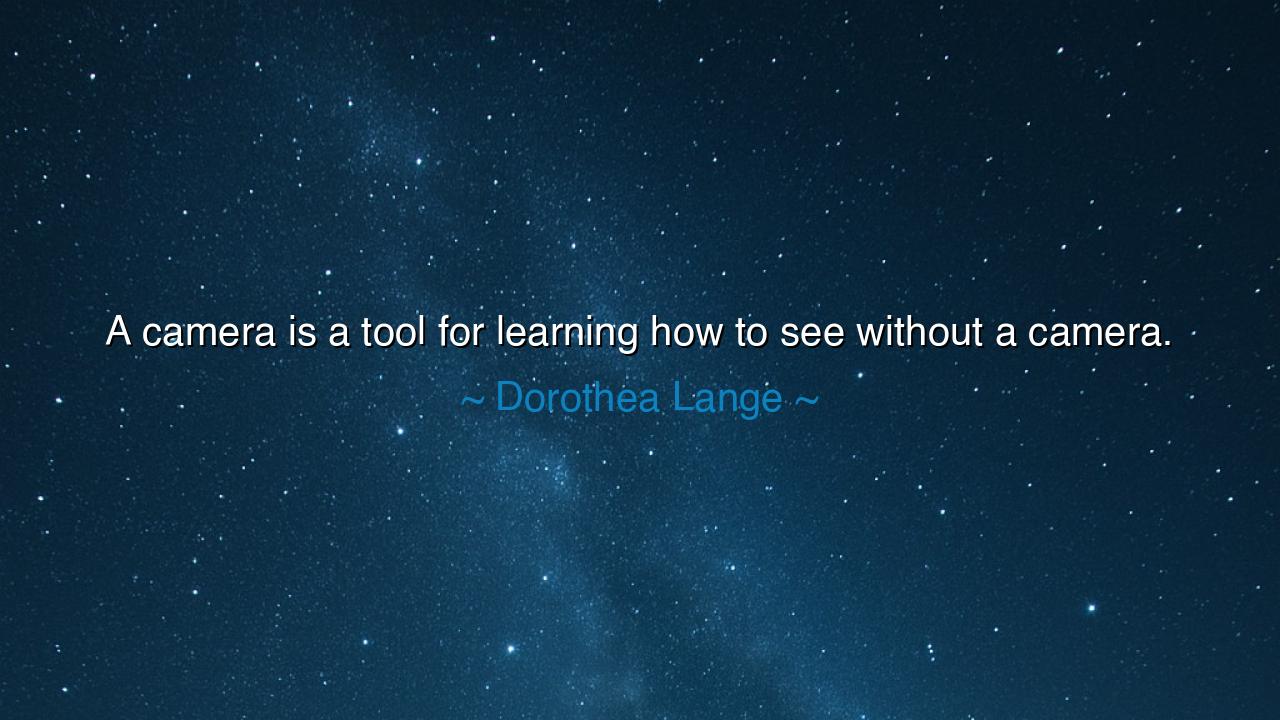
A camera is a tool for learning how to see without a camera.






"A camera," said the seer Dorothea Lange, "is a tool for learning how to see without a camera." In this brief utterance lies a truth both humble and vast — a teaching not only for those who wield lenses and light, but for all who walk this earth with eyes open yet unseeing. For the camera, that small box of glass and metal, is but a mirror of the soul’s own vision. It teaches us not merely to look, but to behold — to notice the trembling leaf, the weary hands, the fleeting sorrow of a stranger’s face. The camera is a teacher of presence, a silent mentor that reveals how beauty hides in the ordinary, and how eternity can dwell within a single moment.
In the time of Lange herself, this truth was forged in hardship. During the Great Depression, she walked among the forgotten, the dust-bitten, the displaced. With her camera, she captured not just images, but human dignity amid despair. Her photograph of the “Migrant Mother” — a woman’s face carved by hunger yet lit by endurance — became a hymn to endurance itself. But what Lange learned, and what she sought to teach, was not simply how to take a picture. She learned how to see — to pierce through circumstance and glimpse the human spirit beneath. The camera was her guide toward a deeper vision, and once she had learned, she no longer needed the camera to behold the truth of the world.
To see without a camera is to walk through life as one awakened. It is to notice the quiet choreography of shadows across the floor, the music of wind through an open window, the unspoken stories carried in a passerby’s eyes. It is to understand that seeing is not of the eyes alone, but of the heart. For what use are eyes that do not perceive wonder, or a lens that does not seek truth? Lange’s wisdom calls us to reclaim our birthright — the sacred art of attention — which the noise of the world too easily steals from us.
Consider also the poet, the sculptor, the philosopher — each begins with a tool, yet each must one day learn to see beyond it. The poet begins with words, but true vision lies in silence. The sculptor begins with stone, but true form dwells in the imagination. Likewise, the photographer begins with the camera, but true sight begins when the camera is set aside. The tool is but a bridge, and once the soul has crossed, it must learn to walk without its crutch.
There was once a monk in the mountains of Japan, who spent his youth painting cherry blossoms. For decades he studied every petal, every shade of pink beneath the morning sun. When he grew old, he cast away his brushes and spent his days gazing at the trees in silence. His disciples asked, “Master, why do you no longer paint?” He replied, “Because I have learned to see.” So it is with Lange’s camera — once it has taught us to perceive, to honor the moment, we must learn to live as if the lens were still in our hands, though invisible.
From this wisdom, let the reader draw a lesson: to see without a camera is to live deliberately, to dwell in awareness rather than in haste. Each day, pause before a familiar thing — a child’s laughter, the wrinkles of an elder’s hand, the dying flame of twilight — and truly see it. Ask not what it is, but what it means. Ask not how it looks, but how it feels. In such practice lies the beginning of art, of empathy, of wisdom itself.
Thus, my child of light, remember: the camera is not the end, but the beginning. It is a door through which the artist, the wanderer, and the seeker must pass. Learn from it. Let it train your gaze to find beauty in the broken, grace in the forgotten, and eternity in the moment. And when your seeing has ripened, set it down. Then, with naked eyes and an awakened soul, go forth — for you will have learned at last how to see without a camera.






AAdministratorAdministrator
Welcome, honored guests. Please leave a comment, we will respond soon